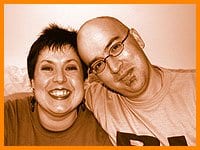After two decades of activism, bisexuals have established a solid community in Toronto. Among other things, they’re using it as a dating pool.
“Bisexual males seem to be such a small minority that meeting outside of a bi environment is unlikely,” says Bernie Fitzpatrick, a 20-year-old engineering student.
But for many bisexuals seeking out bi partners is worth the effort – it means not having to explain multiple-sex attraction or defend against stereotypes that continue to exist in both the gay and straight communities.
“Being with a bi partner gives me complete confidence that I won’t have to closet myself at all, which I might feel inclined to do if dating a straight woman or a gay man,” says Fitzpatrick. The 20-year-old engineering student met his male partner at a social for the Toronto Bisexual Network (TBN).
TBN is the umbrella organization for several smaller groups including Bisexual Women Of Toronto, Bisexual Men Of Toronto and a bi-Pride planning committee. Between meetings, socials, activism and educational events, there’s lots of time to get acquainted with other bi folks.
Some bisexuals make a conscious decision to stick with their own kind. Dana Shaw finds that bi partners are more open to non-traditional relationship structures. Shaw was looking for a woman with whom she could have as strong and committed a relationship as she has with her husband.
“I’d had some experience dating lesbian women and it wasn’t comfortable for me,” says Shaw. “I wanted my two partners to get to know each other and feel comfortable with each other. That didn’t seem possible with lesbian lovers.” She met her female partner, who she refers to as her wife, while appearing on a television panel on sexuality.
Stephen Harvey is one of the founders of TBN. He met his current partners, Amy Payne and Bonnie Prosser, on-line. They all know one another from an e-mail list for bi activists’ and Payne and Prosser, now occasional lovers themselves, are regulars in the Bisexual.org chat room.
Harvey says that subconsciously he was probably seeking bisexual partners. It was the long-distance aspect of the relationship that was a surprise. Prosser lives in Alberta and Payne lives in Indiana.
Cheryl Dobinson, creator of the bi women’s zine The Fence, doesn’t limit her options, but she does have certain criteria. “I didn’t seek out a bi partner in the sense of not considering any other possibilities,” she says. “But I was definitely interested in someone who was bi positive, so having a bi partner was a good way of meeting that need.” She and her partner of two-and-a-half years, Anthony Morris, met at a TBN party.
They all agree that biphobia limits their dating options. Some lesbians and gay men refuse to date bisexuals at all. As well, there is often the expectation that someone who identifies as bisexual going into a relationship will change their tune once the partnership is established. Dating another bisexual means sidestepping the trap of hiding either same-sex or other-sex attractions.
Dobinson says she appreciates that her bi partner doesn’t pressure her to change her sexual identity or treat her bisexuality as a transitional stage. “[He] understands what it’s like to be attracted to both men and women, and doesn’t objectify my interest in women the way some straight men have.”
Allie Kabayama says that the straight men she’s dated haven’t taken her relationships with women seriously. “[Guys] thought that it was totally fine to ask when they could join in on the fun,” says Kabayama. “Obviously [they thought] we were just hanging out until a guy could come along and make it interesting… like some living fantasy porno.”
This emerging bi-on-bi phenomenon will be difficult for most people to spot since observers frequently assume that same-sex bi couples are gay or lesbian. “We were often perceived as a gay couple,” says Fitzpatrick. “The situation can range from irritating to humorous.”
Nineteen-year-old bisexual Suzy Yim and her partner have the same experience. “Most see us as a committed lesbian couple,” says Yim. “I’ve had to explain the concept of bisexuality to a few of them.”
Similarly, other-sex couples are assumed to be straight by both straights and queers. Self-proclaimed “bi computer geeks” Laura Jarvis and Rick Innis say that they get read as a straight guy with a dykey-looking girlfriend, unless they catch on to Rick’s femme qualities. “If they have gaydar, then they’re really confused.” jokes Innis. “We break people’s gaydar.”

 Why you can trust Xtra
Why you can trust Xtra


